Mujaddara
August 28, 2021 • Category: Legumes, Whole Grain/Bulgur/Rice
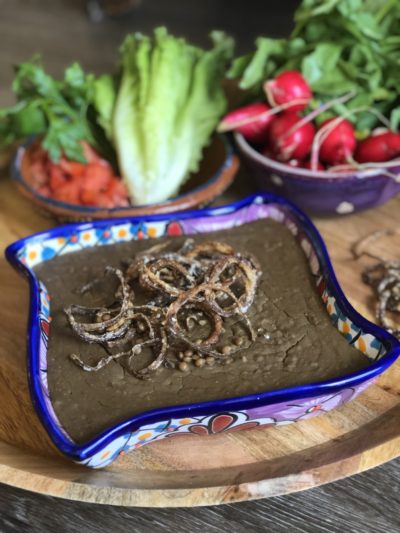
Eleven years ago when I first published this recipe, I was struggling with the Arabic title: Should I include it or should I call it “lentil and rice dish”. Now that our Near Eastern food has become mainstream, I can just call it by its name: mujaddara (pronounced mjaddra in Lebanon).
One caveat, though: This mujaddara is unlike any you will find on the web. It is the mujaddara made in Lebanon, (also known by mujaddara musfayeh), eaten everywhere in homes, school or hospital cafeterias. The mujaddara on the web, basically a rice pilaf, is also made in Lebanon, but is called mudardara. (I will post a recipe for mudardara later).
There are two main differences between the mujaddara and the mudardara: mujaddara is run through a food mill, which makes it silky soft, with only the occasional grains of rice providing texture. It also does not contain lots of rice, just 1/4 to 1/3 cup per batch. The mudardara on the other hand, has equal amounts rice to lentils, and the caramelized onions are sprinkled on top of the rice pilaf. Both are eaten at room temperature.
Mujaddara is mainly made using the large green lentils most commonly found in all markets; however, it can also be made using red split lentils, in which case it is called mujaddara safra
(the word safra means yellow in Arabic). Mujaddara can also be cooked with bulgur, in which case it is called mujaddara hamra or janoubiyeh (hamra is red in Arabic and janoubieh is a reference to the janoub which means South, as it is a traditional version in the South of Lebanon).
Mujaddara has also a glorious past, as Lebanese culinary lore attributes it to the dish that Jacob in the book of Genesis gave up his inheritance rights for. As the story goes, Jacob was working in the fields all day, and came back home starving and asked for a bowl of lentils in exchange for his inheritance. He was given mujaddara!
In the olden days in Lebanon, it was called the dish of the poor, because it contained no meat, and lentils were some of the cheapest foods. However, poor and rich alike would eat it with gusto as it is yummy! Another advantage of mujaddara is that it is served at room temperature. It does not require fussing with oven temperatures or serving it immediately. In Lebanese homes, one could see a dish of mujaddara on the dining table covered with a muslin globe to prevent flies from landing on it, waiting patiently to be devoured one or more hours later. The mujaddara is considered a full meal along with a salad like fattoush or a cabbage salad. Bread and olives are also made available on the table.
The spices used for mujaddara are simply salt, pepper and maybe some allspice or cumin. The main flavor here comes from the caramelized onions, not the spices.

Mujaddara
Joumana Accad Mediterranean, Middle Eastern August 28, 2021 Legumes, Whole Grain/Bulgur/Rice, fasting dish, vegan, Mujaddara, lentils,4-6 servings
Prep Time: 15 minutes
Cook Time: 1 1/2 hours
Ingredients
1 1/2 cup lentils (greens, large or small)
3 onions, of which 2 onions are chopped (medium size, yellow or white) and one large onion sliced into rings to use as topping
1/3 cup oil like a light olive oil, or a vegetable oil (to fry the chopped onions)
Oil bath to fry the onion rings when mujaddara is ready
spices:
salt, to taste; 1/2 tsp.cinnamon, 1/2 tsp.allspice, 1/4 tsp black pepper, 1/2 tsp cumin (optional)
2 tsp sugar (to help caramelize the onions)
1/4 cup flour mixed with a dash of salt (to sprinkle on the onions)
1/4 cup Calrose or Egyptian rice, soaked first if possible in a bowl of water for one hour or longer
Equipment:
Deep skillet with cover or Dutch oven or large pot with cover
Food mill
Spatula
Large spoon
Instructions
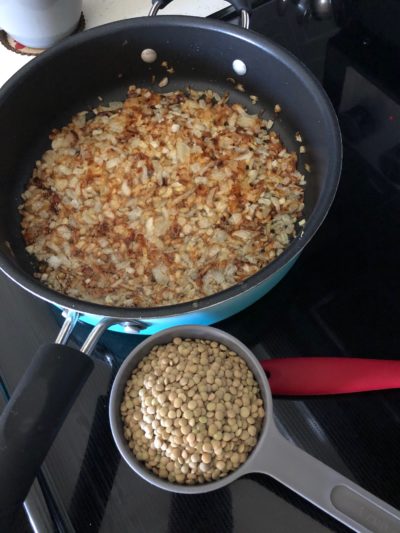
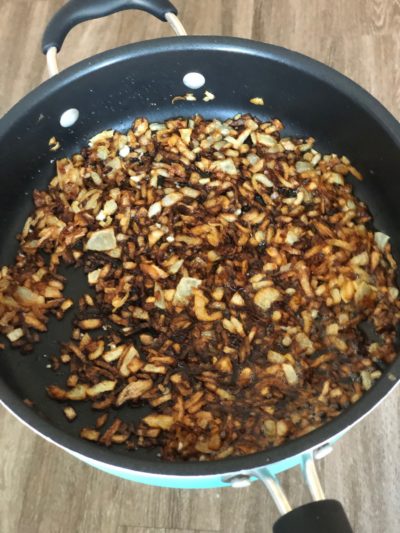
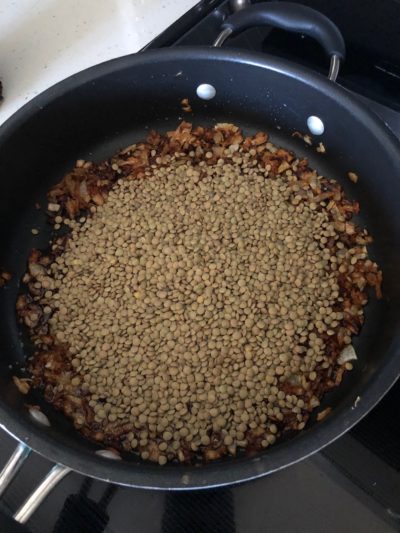
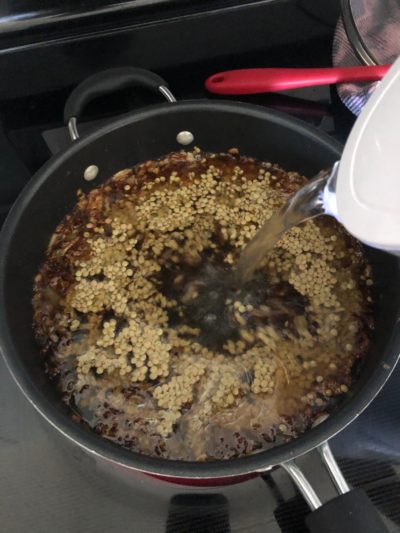
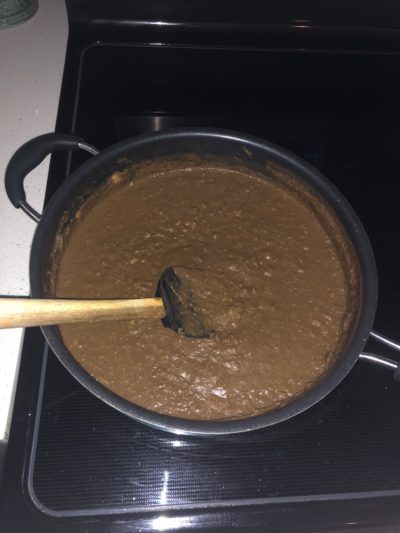
- Fry the chopped onions in the oil over medium heat, watching them from time to time, adding the sugar to speed caramelization, until the onions are browned and caramelized.
- Add the lentils and pour about 8 cups of water over the lentils. Cover the pot and bring to a simmer. Simmer the lentils and onions for about 20-30 minutes until the lentils are cooked.
- Now remove the lentils and onions with a slotted spoon and run them through the food mill (use the medium size disc), until all the lentils have been pureed and the skins remain in the food mill bowl. This will ensure that the mujaddara is silky and has that melt-in-the-mouth quality. Only the food mill will achieve the silky smooth texture, not the food processor or blender.
- Collect the resulting mujaddara (less the skins) and retransfer to the pot. Simmer again, stirring all the way to prevent the bottom from burning and sticking to the pot. Add the rice and spices now and stir some more, from time to time, until the rice cooks thoroughly, about 20 minutes, with the lid over the pot.
- Uncover the pot, and stir some more, until the mujaddara is thick and smooth and starts forming its characteristic skin. Taste to adjust the spices if needed.
- Now transfer the mujaddara to a serving dish and even out the surface with a spatula; let it cool.
- Prepare the onions for the topping, if desired. Sprinkle the onions with salt and let them sit for 30 minutes to sweat. Dry the onions with paper towels and sprinkle with flour. Heat the oil bath and fry the onion rings till golden and crispy, then drain over paper towels. Place over the mujaddara.
- Serve the mujaddara at room temperature, with a salad like fattoush or cabbage salad on the side.
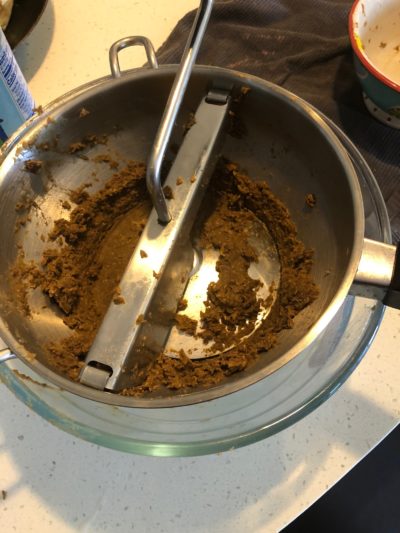
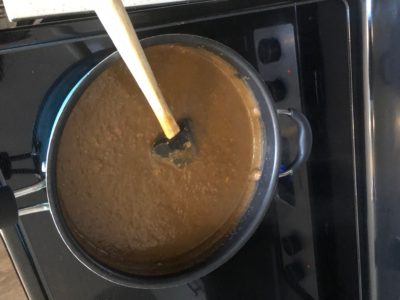
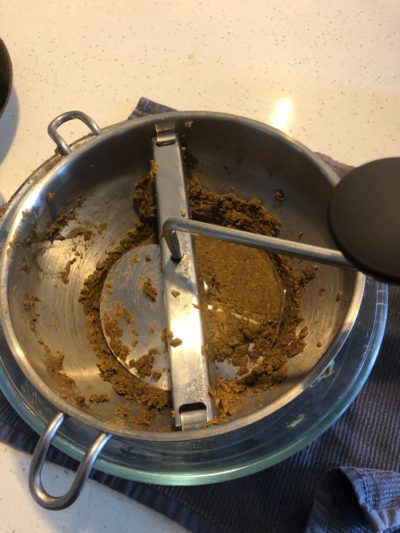
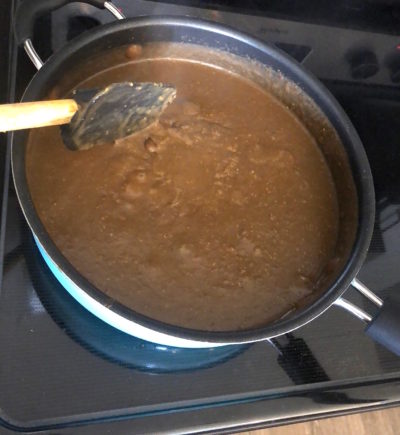
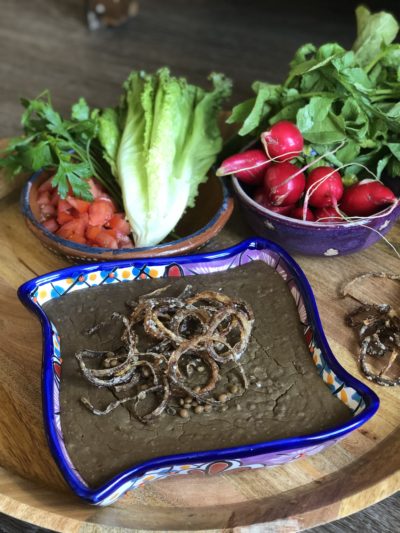
Hello! All photos and content are copyright protected. Please do not use our photos without prior written permission. If you wish to republish this recipe, please rewrite the recipe in your own unique words and link back to the source recipe here on tasteofbeirut.com. Thank you!
Comments
6 Comments • Comments Feed

assad boustani says:
When do you add the spices and seasoning?
On August 28, 2021 at 3:10 pm
Joumana says:
@assad boustani Sorry if that was not clear! you will add the spices when you puree the lentils and put them back in the pot along with the rice. That’s when you will be able to taste and adjust the spices.
On August 30, 2021 at 7:02 pm
joe says:
your commentaries are as good and beautiful as your recipes.
thank you a million, from Beirut, my home
On August 28, 2021 at 3:45 pm
Joumana says:
@joe So happy to hear you like my little blog!
On August 30, 2021 at 7:02 pm
Kim says:
Thank you for sharing this recipe!
In the mid-1990\’s I first ate mujaddara at a Lebanese restaurant in Halifax, Canada., called Beirut Beirut I ate there every week, and this was one of the things I always ordered. Eventually they gave me the recipe when I mentioned that I was looking for recipes for children who needed to have soft food diets.
Since then I have made this recipe many times, but have never seen a recipe this close to the one I make. Most recipes are the rice and lentil pilaf style recipe that you mention. But this is my favourite! I have always meant to write up the recipe on my blog, and hope to do so one day. I think I was waiting to visit Lebanon first to learn more about traditional cooking, but this might not happen for a while, so maybe I just need to write it up!
Thanks again!
On March 21, 2022 at 5:06 am
Joumana Accad says:
@Kim Thank you for leaving such an interesting and thoughtful comment! I am glad you are able to use it ! Lots of different types of mujaddara in Lebanon depending on the region and the community. I may do the next one on the mujaddra safra (yellow), made in some communities, with orange lentils and a bit of rice or bulgur.
On March 22, 2022 at 12:27 am